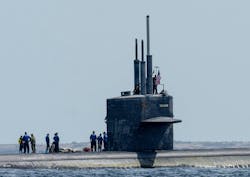Navy asks Lockheed Martin for multifunction submarine masts for electronic surveillance and imaging sensors
Questions and answers:
- What is the purpose of the Multifunction Modular Masts (MMM) being developed by Lockheed Martin? The MMMs are designed to lift various sensor systems above the water's surface on Virginia-class submarines, improving stealth, reliability, and durability without traditional periscopes.
- How do the MMMs enhance submarine stealth compared to traditional periscopes? MMM systems use optical fibers and non-hull-penetrating designs, which prevent the need for a traditional periscope, enhancing the submarine's stealth capabilities.
- What types of sensors can be integrated into the Multifunction Modular Masts? The MMMs can carry a variety of sensors, including electro-optical imagers, electronic warfare antennas, satellite communications, and underwater sensors.
WASHINGTON – Undersea warfare experts at Lockheed Martin Corp. will provide the U.S. Navy with lifting mechanisms to raise different sensor systems above the water's surface aboard the Navy's fleet of Virginia-class fast attack submarines under terms of a $57.3 million contract announced late last month.
Officials of the Naval Sea Systems Command in Washington are asking the Lockheed Martin Rotary and Mission Systems segment in Syracuse, N.Y., to build Multifunction Modular Masts (MMM) for new-construction and in-service Virginia-class submarines.
Submarine Multifunction Modular Masts serve as lifting mechanisms aboard submarines like the Virginia class that do not have traditional periscopes penetrating the pressure hull.
These multifunction masts raise different kinds of sensor payloads above the water's surface. Instead of a traditional submarine periscope that goes through the vessel's pressure hull, the Multifunction Modular Masts use optical fibers and non-hull-penetrating designs to bring sensor information into the submarine, which improves the submarine's stealth, reliability, and durability.
Tell me more about how submarines can operate without traditional hull-penetrating periscopes ...
- Modern submarines increasingly use non-penetrating photonic masts and advanced sensors. Photonic masts use raise sensors above the water's surface and move data into the submarine via optical fibers. They carry high-resolution digital cameras, infrared sensors, and laser rangefinders. Optical masts need a smaller opening for cables than do traditional periscopes, and reduce vulnerability and improve structural integrity. Visual feeds display on several flat-panel screens in the submarine's command center, which enables several crew members to view and analyze imagery simultaneously, instead of using a traditional periscope that only one person at a time can look through.
The MMM hosts several types of sensors like electro-optical imaging sensors, electronic warfare (EW) antennas, line-of-sight and satellite communications (SATCOM), and underwater sensors, and moves sensor information to the submarine's combat center and video monitors throughout the vessel.
The MMM is reconfigurable so it can raise and lower different sensor packages above the water using noiseless raising and lowering controls, and enables the submarine to move high-speeds at periscope depth. It can host electro-optical imaging sensors, as well as RF and microwave sensors for EW and electronic surveillance.
Virginia-class submarines have banks of eight MMM sensor masts, which integrate with other undersea warfare systems like the AN/BLQ-10 EW system to enhance reconnaissance and threat detection.
This contract has options that could increase its value to as much as $202.8 million. On this contract Lockheed Martin will do the work in Syracuse, N.Y., and should be finished by July 2030. For more information contact Lockheed Martin Rotary and Mission Systems online at www.lockheedmartin.com/en-us/news/features/history/submarines.html.
About the Author
John Keller
Editor-in-Chief
John Keller is the Editor-in-Chief, Military & Aerospace Electronics Magazine--provides extensive coverage and analysis of enabling electronics and optoelectronic technologies in military, space and commercial aviation applications. John has been a member of the Military & Aerospace Electronics staff since 1989 and chief editor since 1995.
